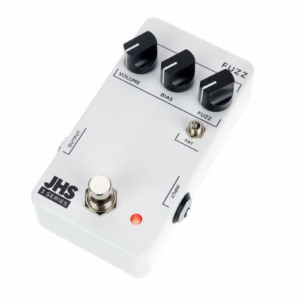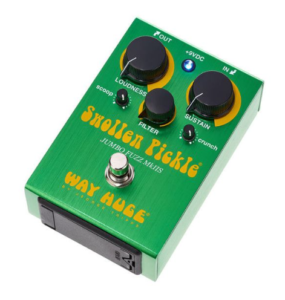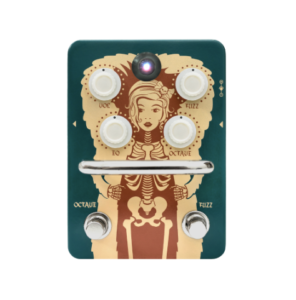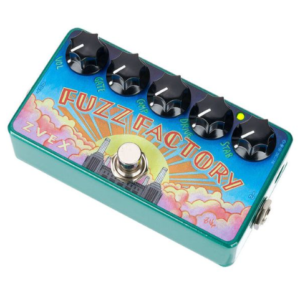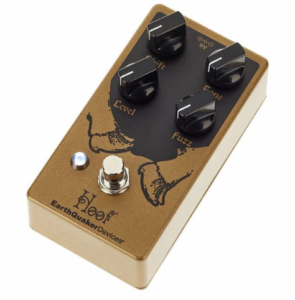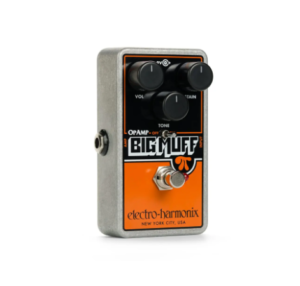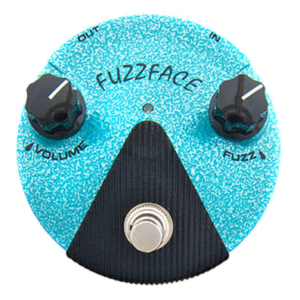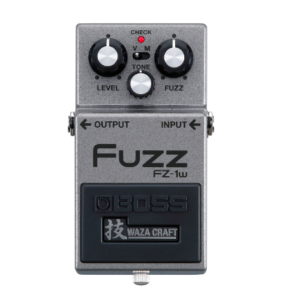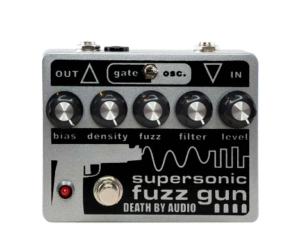The best Fuzz Pedals vary widely in performance, parameters, and features, so this list has options for every genre and playing style. Let’s start this article by showing you the best fuzz pedals in each price range.
Top 10 Best Fuzz Pedals
1. JHS 3 Series Fuzz
The incredibly easy-to-use and versatile JHS Pedals 3 Series Fuzz is a no-frills fuzz pedal that covers a wider range than you might think.
It’s a 60s-style fuzz, but its goal is to give you access to all the settings (unlike many vintage models!). There are plenty of great tones to suit a variety of guitars and pickups.
The Bias control lets you dial in more or less voltage, which can give you some really cool, popping sounds. But dial it down and you’ll get some really responsive, dynamic tones.
The fuzz knob has a huge range. When turned down, it’s almost like a push amp, but the more you turn it up, the louder and fuzzy it gets.
Halfway through, you’ll get a thicker, fuller tone. Then there’s the thick toggle switch that thickens the signal.
2. The Huge Swollen Pickle
The Swollen Pickle is without a doubt one of the most versatile pedals on this list. With so many adjustable parameters, you can essentially create your own unique combination of fuzz and filter.
It’s a gorgeous pedal in terms of looks, and at $150, it’s arguably one of the best fuzz pedals in its price range. With the Swollen Pickle, you can create just about any kind of fuzz you can imagine.
While we found plenty of tones that are ready to use right out of the box, this isn’t a pedal that everyone will love right away.
It’s not a plug-and-play pedal, and it takes a bit of tweaking to unlock the full range of sounds. It also has so many controls that it might be a bit overwhelming for beginners who are curious about fuzz.
Nevertheless, I highly recommend this pedal to any guitarist who enjoys experimenting to create individual and unique sounds.
3. Orange Fur Coat Fuzz Pedal
The Fur Coat is one of the best fuzz pedals for guitarists looking for variety, thanks to its combination of a standard fuzz pedal and a footswitched octave that allows you to mix in fuzz with an adjustable amount.
With the EQ set fairly neutral, the fuzz generally has a vintage sound. It’s fat, warm, and has plenty of low-end.
The EQ knob covers a huge range in a similar style to the Big Muff, allowing you to dial in everything from squishy to snarly. Switching through the octaves changes things dramatically.
At its lowest setting, the octave adds a bit of tonal variation, slightly increasing the presence.
Cranking the octaves makes that change even more pronounced, with a distinct second note, the octave, becoming more pronounced.
The octave fuzz sounds beautiful, especially at higher levels, where single sustained notes feed back and the upper notes resonate.
4. Z.Vex Fuzz Factory
Using a combination of germanium transistors, a feedback loop, and a control that allows the user to over-bias the internal circuitry, the Fuzz Factory is versatile in a way that most pedals aren’t.
Want to reduce the input voltage so that the pedal is isolated from vibration? Go ahead. Want to feed the output of a block back to itself? Absolutely!
That’s why it was a breath of fresh air when it came out, and it gave Z.Vex a foundation on which to build an unusual empire.
Sound-wise, it’s part of the Fuzz Face family, so with a little tweaking you can get some pretty subdued blues lead tones out of the pedal, but it really shines when it’s a screaming awl in a velcro-fuzz maelstrom.
Even though it seems like there are more and more pedal companies out there by the day, the humble Fuzz Factory has a simple, elegant, and thrillingly rebellious element to it.
5. Jim Dunlop Mini Germanium Fuzz Face
The Jim Dunlop Fuzz Face Mini is a monster. Despite its compact design, it packs quite a punch.
The tone of this pedal sounds like it came straight out of the late 60s, with no artificial undertones to ruin the authenticity of the sound.
If you’re a fan of Jimi Hendrix and want to emulate his dynamic range, this pedal will give you the response you need. I’ve never used a pedal that reacts to guitar volume as well as the Germanium Fuzz Face.
The timeless transistors make this pedal a real treat for the vintage purist.
Overall, it is a compact and great pedal for a warm, low-gain fuzz sound that’s authentic to the 60s.
6. EarthQuaker Devices Hoof V2
Ohio-based pedal manufacturer EarthQuaker Devices is known for its unique takes on classic circuits, and the Hoof is arguably one of their most popular pedals. And for good reason.
Inspired by the iconic green Russian Big Muff, the Hoof uses a hybrid germanium/silicon design for a unique sound and unparalleled temperature stability.
So if you’re looking for a unique take on an iconic pedal that’s become a modern classic, the EarthQuaker Devices Hoof is worth checking out. But be warned, it might not leave your board ‘off the hook’.
7. Electro-Harmonix Op Amp Big Muff
This nano-sized pedal boasts the usual Big Muff triumvirate of volume, tone, and sustain knobs, but also includes a switch to bypass the tone knob.
Compared to what you’d get from a typical transistor-based Big Muff, there’s a slightly rougher sound, with a rougher underlying crunch that’s perfect for sloppy ripping and thick, heavy chord work.
There’s a sweet spot between the extremes where you can dial in just the right amount of razor-sharp presence using the tone knob, or alternatively flick the tone bypass to go straight for a more utilitarian sound that cuts through the mix.
Those specifically looking for that famous Smashing Pumpkins tone can find it in this reasonably priced compact pedal from the original manufacturer.
Even if that’s not your cup of tea, you’ll find a solid source of razor-sharp, fuzzy distortion that’s perfect for all sorts of heaviness.
Not only is the Big Muff a must-have for your pedalboard, it’s also one of the best affordable fuzz pedals for those on a tight budget.
8. Dunlop FFM3 Jimi Hendrix Fuzz Face Mini
The Fuzz Face is one of the most iconic guitar effects pedals of all time, and its mic stand-bottom-inspired enclosure has barely changed since its release in 1966.
The FFM3 Jimi Hendrix is a miniature version of the original JHF1. Circuit-wise, the FFM3 Jimi Hendrix has the same internals as the full-size version, including BC108 silicon transistors and a modern, compact printed circuit board designed to cover a wide range of Jimi fuzz tones.
The most notable thing about the tone is that the FFM3 delivers a powerful kick in the midrange.
Not only does it offer better note clarity than its rival Fuzz Faces, it also makes the FFM3 a great choice for boosting overdrive amps and cutting through mixes. Switching to the neck pickup also unearths some delicious octave overtones.
9. Boss Waza Craft FZ-1W
The Waza Craft series took the pedal world by storm when it was released in 2014, and Boss has been steadily adding to this popular lineup ever since.
This premium pedal is made in Japan using the highest quality components and features the classic sound of the original pedal, as well as switchable modes for custom tones.
The Boss FZ-1W is an incredibly versatile fuzz that lets you switch between modern and vintage tones with ease.
The Modern mode is timbre-tuned for a bright, clear sound with a decent amount of gain, while the FZ-1W’s Vintage setting delivers classic early 60s tones.
10. Death by Audio Supersonic Fuzz Gun
Death by Audio was founded by Oliver Ackermann, who is probably better known as the guitarist for pioneering noise rockers A Place To Bury Strangers.
As you might expect, they make extreme, experimental, and quirky pedals. They have some great reverbs, delays, flangers, and all sorts of other pedals.
The Supersonic Fuzz Gun follows the same design strategy used for many early DBA circuits, which seems to be ‘throwing parts on a breadboard until it sounds cool’.
I’m also not entirely sure that the descriptions of the controls on the front plate are accurate in how they change the sound of the pedal.
A big part of the fun of SSFG is that it’s not the kind of product that the big manufacturers wouldn’t make. It’s a reflection of the creator’s personality in that it’s unique and confusing.
If you want something that’s punk as hell, this is definitely the best fuzz pedal for you.
FAQ
What’s the best fuzz pedal?
Determining the best fuzz pedal is subjective. Fuzz pedals come in a variety of sonic flavors. They react differently to things like your guitar’s volume knob and other pedals in your signal chain.
As a result, there is no universal best fuzz pedal. Instead, you should choose one based on your preferred tone.
To make an informed decision, consider the sound you want to achieve, ask fellow guitarists who are experienced with fuzz pedals, and experiment with different options using your specific guitar and amp.
Fuzz pedals come in a variety of styles, including Fuzz Face, Big Muff, Tone Bender, and Octafuzz, giving you plenty of room to explore.
How do fuzz pedals work?
What all fuzzes have in common is that they have a lower clipping threshold than distortion pedals, resulting in an almost perfect square wave. This is why some fuzzes sometimes sound like synthesizers.
The main difference in the sound of a fuzz is the transistors used. Vintage-voiced fuzzes, such as the Fuzz Face, use germanium transistors to produce a warm, mid-gain sound.
More aggressive fuzzes, such as the Big Muff, tend to use silicon transistors to produce a harsher, more compressed tone.
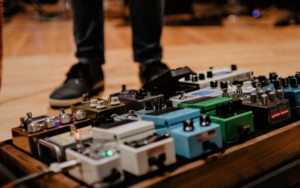
What’s the difference between a Germanium and a Silicon fuzz pedal?
When delving into the realm of fuzz pedals, the terms germanium and silicon refer to the type of transistors used within the pedal circuit.
These components have a significant impact on the overall sound character of the pedal.
In general, fuzz pedals equipped with germanium transistors are known for producing a warmer tone, lower gain compared to most silicon transistors, and their ability to clean up gracefully.
On the other hand, silicon transistor-based fuzz pedals, such as the BC108, are known for their higher gain, brighter tone quality, and greater stability against external factors such as temperature changes.
What’s the difference between fuzz, overdrive, and distortion?
There is a fierce debate about the composition of fuzz and overdrive or distortion.
For what it’s worth, our rule of thumb is that most fuzz pedals work by clipping transistors instead of using diodes to ‘clip’ the top and bottom of the guitar signal waveform.
But… that doesn’t work very well. One of the most famous fuzz pedals, the Big Muff, uses two sets of soft-clipping diodes to achieve its distinct square wave fuzz tone. One of the most famous distortion pedals.
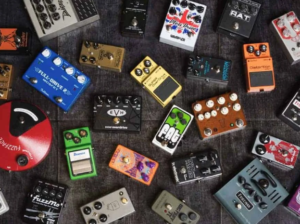
Are fuzz pedals loud?
Some are noisy, some are not, but using any kind of pedal that boosts the input signal, such as an overdrive or distortion pedal, will inevitably increase the tone with some noise.
Some fuzzes, like the Fuzz Factory, have a built-in noise gate that helps reduce the noise when you’re not playing, which is very effective.
Others, like the Big Muff, don’t have this, so you’ll need to buy a separate noise gate pedal to tame the hiss.
Pickups also play an important role when using a fuzz pedal. Single coils are generally much more susceptible to external noise, making them difficult to handle at high-gain settings with a fuzz pedal.
This noise can be exacerbated by poorly shielded electronic cavities on your guitar, or by the order of your pedals on your pedalboard.
Also read: Best Metal Practice Amps for 2025

